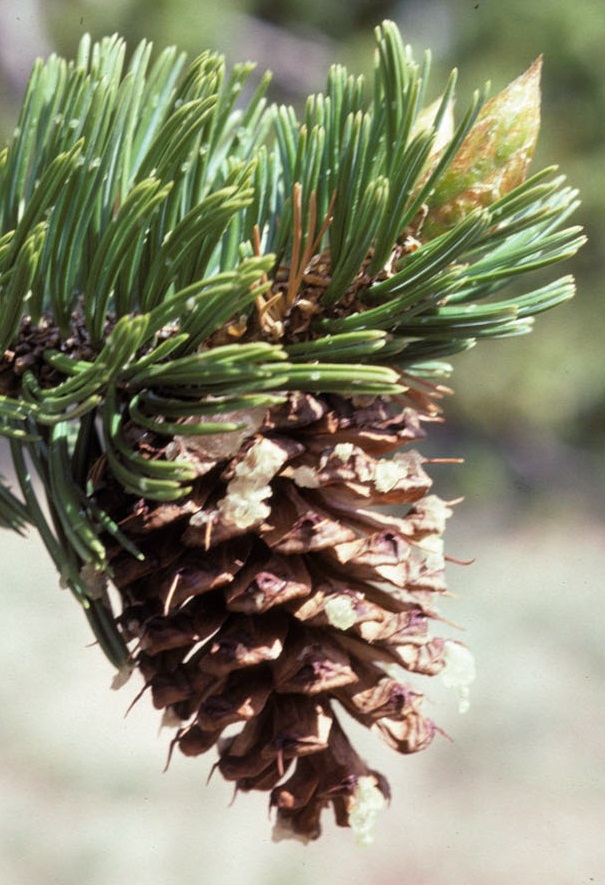 Native Pines - November 26, 2014 Jeff Schalau, Agent, Agriculture & Natural Resources University of Arizona Cooperative Extension, Yavapai County Pine trees are an important component of Arizona’s native ecosystems and often act as the foundation species for corresponding habitats and food webs. Pines are gymnosperms that belong to the genus Pinus. Gymnosperms (Greek meaning “naked seed”) include the conifers (cone-bearing plants), the cycads, the gingko tree, as well as tropical plants in the genus Gnetum. Pines are resinous evergreens with a whorled branch structure. Most have thick, scaly bark. Juvenile foliage occurs as single “needles” which are morphologically different from adult needles which occur in fascicles (bundles) ranging from 1 to 6, but most commonly 2 to 5. Pines are mostly monoecious: having male and female cones on the same tree. Male cones are small and are shed soon after they have released their pollen. Wind disperses the pollen. Female cones are fertilized and mature within 1.5 to 3 years. Seeds are released from the cones either by natural ripening or by the heat of fire (called serotinous cones) in highly fire-adapted species. Animals and birds often feed on the seeds and disperse them in the process. Each of the Arizona pines has a unique niche and all are important to the ecosystems where they occur. Ponderosa pine (Pinus ponderosa) is widely distributed in Arizona occurring in nearly pure stands between 5,500 and 8,000 feet, but can occur down to 3,500 and up to 9,500 feet. In Arizona, it can grow to 125 feet in height and over 3 feet in diameter. In northern Arizona, it primarily has 3 needles per fascicle, but in southern Arizona, there are subspecies having 5 needles per fascicle. It is very desirable for timber and northern Arizona has the largest contiguous stand in North America. Colorado pinyon (P. edulis), single-leafed pinyon (P. monophylla), and Mexican pinyon (P. cembroides) are the three pinyon species found in Arizona. Each produces a delicious nut. The Colorado pinyon has two needles per fascicle and is the most widely distributed and abundant pinyon species. Single-leafed pinyon is virtually identical to the Colorado pinyon except it has mostly one needle per fascicle. Some believe these two species to be very closely related. Both are found in the northern portions of Arizona between elevations of 4,000 to 7,000 ft. The Mexican pinyon has 3 needles per fascicle and is found in the southern portions of Arizona between elevations of 5,000 and 7,000 feet. In Arizona, bristlecone pine (P. aristata) is limited to the San Francisco Peaks between elevations of 9,500 and 12,000 feet. The needles usually occur in groups of 5 per fascicle and are deep green. They are the oldest known, single living organism (non-clonal plant) on the planet having reaches ages of almost 5,000 years (one is known to have reached 4,844 years when it was cut down in 1964). It is sometimes used as a small tree in landscape plantings. Limber pine (P. flexilis) is found on the San Francisco Peaks, the White Mountains, and the Pinaleno Mountains above 8,000 feet. It has 5 needles per fascicle and often has drooping limbs and a short trunk. Southwestern white pine (P. reflexa) is found in the White Mountains, the sky islands of southern Arizona and south into Mexico between elevations of 6,500 and 10,000 feet. It has 5 needles per fascicle and it is distinguished from limber pine by the absence of stomata on the backs of the leaves (get out your microscope and have a look). Chihuahuan pine (P. chihuahuana) is found south of White River and the Pinaleno, Pinal, Chiricahua, Santa Catalina, and Santa Rita mountains. It is found mostly on dry slopes and benches between 5,000 and 7,500 feet and has 3 needles per fascicle. Apache pine (P. latifolia) is found in the Chiricahua, Huachuca, Dragoon, and Santa Rita mountains. It has very long needles (10 to 15 inches) that occur in 3 needles per fascicle. This gives it some resemblance to the longleaf pine of the southeastern U.S. but its growth form is more similar to Ponderosa pine. See below for additional information and resources. Follow the Backyard Gardener on Twitter – use the link on the BYG website. If you have other gardening questions, call the Master Gardener help line in the Camp Verde office at 928-554-8999 Ext. 3 or e-mail us at verdevalleymg@gmail.com and be sure to include your name, address and phone number. Find past Backyard Gardener columns or provide feedback at the Backyard Gardener web site: http://cals.arizona.edu/yavapai/anr/hort/byg/. Additional Resources Pines of Arizona University of Arizona Cooperative Extension extension.arizona.edu/sites/extension.arizona.edu/files/pubs/az1584.pdf Yavapai County Native & Naturalized Plants University of Arizona Cooperative Extension, Yavapai County cals.arizona.edu/yavapaiplants/ |